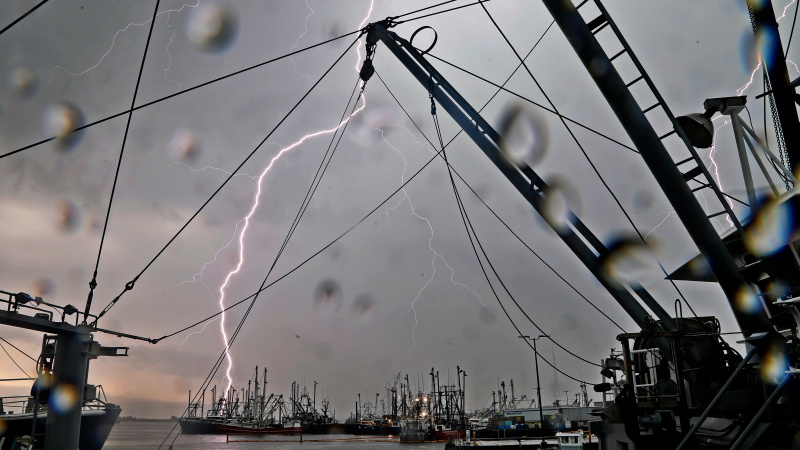Blistering heat wave in West set to stretch into weekend and could break more records
Millions of people across parts of California, Nevada, Arizona, New Mexico and Utah are under heat advisories Friday as meteorologists expect triple-digit temperatures across a swath of the Southwest – again.
It's another day of scorching, potentially record-breaking heat in the region as the first major heat wave of the year stretches into the weekend and likely next week, according to the National Weather Service.
Multiple cities – including Fresno, California; Las Vegas, Reno and Ely, Nevada; and Tucson, Phoenix and Flagstaff, Arizona – may have their records reset on Friday, AccuWeather said.

Record highs across Southeast; Florida under heat advisories
On Thursday, Las Vegas reached a high of 111 degrees, making it the earliest recorded date the city has ever reached such a searing temperature, according to the region's National Weather Service office. Death Valley reached 122 degrees, surpassing the previous record of 121 set in 1996.
In Texas, San Angelo reached a daily high on Tuesday when temperatures reached 111 degrees. And across California, multiple cities broke daily records this week, including Santa Rosa, Palmdale in Los Angeles County and Bishop – all with temperatures well into the triple digits.

Meanwhile, scorching heat is also impacting the Southeast, especially Florida. On Thursday, Sanford – a city just north of Orlando – hit 101 degrees, tying the daily record last set in 1998. The forecast for cities including Miami, Palm Beach and Boca Raton says they are set to experience "feel-like" temperatures up to 110 degrees. Across the state, temperatures could reach 5 to 10 degrees above historical averages through the weekend, according to AccuWeather.
In California, Friday's heat is expected to scorch eastern San Diego County with dangerously hot conditions and temperatures as high as 108 degrees, the National Weather Service said. Meteorologists also warned of temperatures between 105 to 111 degrees expected throughout the Tucson, Arizona area. Meanwhile, Las Vegas could reach temperatures between 107 to 114 degrees.
Heat leads to 11 hospitalizations at Arizona Trump rally
The relentless heat is partly related to a heat wave that scorched Mexico the past few weeks, leading to dozens of deaths. Now, as the heat dome parks over the Southwest, officials are issuing advisories and urging people to avoid strenuous activity outside.
"Drink plenty of fluids, stay in an air-conditioned room, stay out of the sun, and check up on relatives and neighbors," the weather service warned. "Do not leave young children and pets in unattended vehicles. Car interiors will reach lethal temperatures in a matter of minutes."
On Thursday, at least 11 people at a Donald Trump rally in Phoenix were hospitalized in heat-related incidents outside a church, which was packed to capacity. Temperatures in Phoenix reached 112 degrees at Phoenix Sky Harbor International Airport on Thursday, breaking the previous daily record from 2016.
The Phoenix Fire Department on Thursday reminded residents that Camelback Mountain and Piestewa Peak were closed for hiking, as is protocol when the area is under an excessive heat warning.
"With temperatures hitting near 110 degrees, it's not the day for hiking," the department said.
Sean Benedict, lead meteorologist for the Phoenix weather service, told the Arizona Republic that such high temperatures were not "too uncommon" around this time of year.
"We are into the summer now," he said. "It just comes down to getting the right set up, which we do have with a strong high pressure over the area."
Storms to lash Plains region; 7 tornadoes confirmed across mid-Atlantic
While the Western and Southern U.S. faces sweltering heat, forecasters expect a slew of thunderstorms to bring heavy rain, high winds and possible damaging winds to the Plains region on Friday.
More than three million people across Nebraska, Kansas, Missouri and Iowa were under enhanced risk of severe storms beginning in the afternoon and continuing into the night, according to the weather service Storm Prediction Center. As storms form and develop, supercells — the most powerful thunderstorm type — could break out over the region, raising the threat of winds capable of uprooting trees and knocking out power.
Earlier in the week, a barrage of storms swept across much of the central and eastern U.S., spinning up tornadoes across the Midwest and mid-Atlantic region. In Michigan, a toddler was killed and the boy’s mother and her 2-month-old infant were hospitalized on Wednesday after a tree fell onto their home. Multiple injuries were reported across the mid-Atlantic, though the damage was much less substantial than in the Midwest.
On Friday, the weather service confirmed at least seven tornadoes had touched down in Maryland, Virginia and West Virginia, some with winds over 100 mph.
Contributing: Fernando Cervantes Jr. and Sabine Martin, Arizona Republic
Disclaimer: The copyright of this article belongs to the original author. Reposting this article is solely for the purpose of information dissemination and does not constitute any investment advice. If there is any infringement, please contact us immediately. We will make corrections or deletions as necessary. Thank you.





